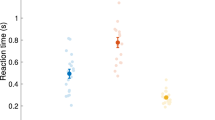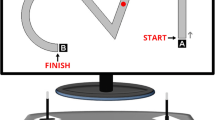Abstract
Motor skills are commonly acquired through practice. This process not only involves acquisition of the particular task demands but also requires overcoming pre-existing modes. In the present study, interactions between new and intrinsic dynamics were evaluated. Accordingly, bimanual finger tapping with a 2:1 ratio was performed according to two training schedules: continuous (consecutive trials) and interrupted (non-consecutive trials with intermediate 1:1 in-phase performances). In addition, in-phase and anti-phase were probed before and after training. Behavioral output was assessed by means of temporal accuracy and variability, whereas neural activation patterns were determined by EEG coherence. Results showed that continuous practice resulted in improved performance with reduced coherence across the motor network. For interrupted practice, behavioral execution ameliorated, although it was inferior to performance with continuous practice. In terms of neural changes, the degree of intrahemispheric and midline connectivity did not reduce with interrupted practice, whereas interhemispheric connectivity increased. This signifies that short-term motor consolidation of the 2:1 task was disrupted due to intermediate performance of the in-phase mode. Furthermore, the probed in-phase and anti-phase pattern showed no behavioral changes, although neural alterations occurred that depended on training schedule and coordination mode. Overall, the observations illustrate bidirectional interactions between new and inherent dynamics during motor acquisition, raising issues about effective methods for learning skills and scheduling of practices in neurorehabilitation.






Similar content being viewed by others
References
Bays PM, Flanagan JR, Wolpert DM (2005) Interference between velocity-dependent and position-dependent force-fields indicates that tasks depending on different kinematic parameters compete for motor working memory. Exp Brain Res 63:400–405
Belger A, Banich MT (1998) Costs and benefits of integrating information between the cerebral hemispheres: a computational perspective. Neuropsychology 12:380–398
Brashers-Krug T, Shadmehr R, Bizzi E (1996) Consolidation in human motor memory. Nature 382:252–255
Chen YC, Thaler D, Nixon PD, Stern CE, Passingham RE (1995) The functions of the medial premotor cortex. II. The timing and selection of learned movements. Exp Brain Res 102:461–473
Debaere F, Wenderoth N, Sunaert S, Van Hecke P, Swinnen SP (2004) Changes in brain activation during the acquisition of a new bimanual coordination task. Neuropsychologia 42:855–867
Doyon J, Benali H (2005) Reorganization and plasticity in the adult brain during learning of motor skills. Curr Opin Neurobiol 15:161–167
Duque J, Mazzocchio R, Dambrosia J, Murase N, Olivier E, Cohen LG (2005) Kinematically specific interhemispheric inhibition operating in the process of generation of a voluntary movement. Cereb Cortex 15:588–593
Erdler M, Windischberger C, Lanzenberger R, Edward V, Gartus A, Deecke L, Beisteiner R (2001) Dissociation of supplementary motor area and primary motor cortex in human subjects when comparing index and little finger movements with functional magnetic resonance imaging. Neurosci Lett 313:5–8
Fink GR, Marshall JC, Halligan PW, Frith CD, Driver J, Frackowiak RSJ, Dolan RJ (1999) The neural consequences of conflict between intention and the senses. Brain 122:497–512
Fontaine RJ, Lee TD, Swinnen SP (1997) Learning a new bimanual coordination pattern: reciprocal influences of intrinsic and to-be-learned patterns. Can J Exp Psychol 51:1–9
Franz EA, Zelaznik HN, McCabe G (1991) Spatial topological constraints in a bimanual task. Acta Psychol 77:137–151
Gerloff C, Corwell B, Chen R, Hallett M, Cohen LG (1998) The role of the human motor cortex in the control of complex and simple finger movement sequences. Brain 121:1695–1709
Grefkes C, Eickhoff SB, Nowak DA, Dafotakis M, Fink GR (2008) Dynamic intra- and interhemispheric interactions during unilateral and bilateral hand movements assessed with fMRI and DCM. Neuroimage 41:1382–1394
Haslinger B, Erhard P, Altenmüller E, Hennenlotter A, Schwaiger M, Gräfin von Einsiedel H, Rummeny E, Conrad B, Ceballos-Baumann AO (2004) Reduced recruitment of motor association areas during bimanual coordination in concert pianists. Hum Brain Mapp 22:206–215
Hummel F, Andres F, Altenmüller E, Dichgans J, Gerloff C (2002) Inhibitory control of acquired motor programmes in the human brain. Brain 125:404–420
Johansen-Berg H, Matthews PM (2002) Attention to movement modulates activity in sensori-motor areas, including primary motor cortex. Exp Brain Res 142:13–24
Kelso JA (1984) Phase transitions and critical behavior in human bimanual coordination. Am J Physiol Regul Integr Comp Physiol 246:R1000–R1004
Kelso JA, Zanone PG (2002) Coordination dynamics of learning and transfer across different effector systems. J Exp Psychol Hum Percept Perform 28:776–797
Kelso JAS, Southard DL, Goodman D (1979) On the coordination of two-handed movements. J Exp Psychol Hum Percept Perform 5:229–238
Kelso JA, Holt KG, Rubin P, Kugler PN (1981) Patterns of human interlimb coordination emerge from the properties of non-linear, limit cycle oscillatory processes: theory and data. J Mot Behav 13:226–261
Kinsbourne M (1970) The cerebral basis of lateral asymmetries in attention. Acta Psychol 33:193–201
Kostrubiec V, Tallet J, Zanone PG (2006) How a new behavioral pattern is stabilized with learning determines its persistence and flexibility in memory. Exp Brain Res 170:238–244
Krakauer JW, Ghez C, Ghilardi MF (2005) Adaptation to visuomotor transformations: consolidation, interference, and forgetting. J Neurosci 25:473–478
Krakauer JW, Mazzoni P, Ghazizadeh A, Ravindran R, Shadmehr R (2006) Generalization of motor learning depends on the history of prior action. PLoS Biol 10:1798–1808
Lee TD, Magill RA (1985) Can forgetting facilitate skill acquisition? In: Goodman D, Wilberg RB, Franks IM (eds) Differing perspectives in motor learning, memory, and control. Elsevier, Amsterdam, pp 3–22
Macar F, Vidal F (2002) Time processing reflected by EEG surface Laplacians. Exp Brain Res 145:403–406
Maslovat D, Chus R, Lee TD, Franks IM (2004) Contextual interference: single task versus multi-task learning. Motor Control 8:213–233
Nowicka A, Grabowska A, Fersten E (1996) Interhemispheric transmission of information and functional asymmetry of the human brain. Neuropsychologia 34:147–151
Oldfield RC (1971) The assessment and analysis of handedness: the Edinburgh inventory. Neuropsychologia 9:97–113
Proteau L, Marteniuk RG, Lévesque LA (1992) Sensorimotor basis for motor learning: evidence indicating specificity of practice. Q J Exp Psychol A 44:557–575
Puttemans V, Wenderoth N, Swinnen SP (2005) Changes in brain activation during the acquisition of a multifrequency bimanual coordination task: from the cognitive stage to advanced levels of automaticity. J Neurosci 25:4270–4278
Rémy F, Wenderoth N, Lipkens K, Swinnen SP (2008) Acquisition of a new bimanual coordination pattern modulates the cerebral activations elicited by an intrinsic pattern: an fMRI study. Cortex 44:482–493
Rowe J, Friston K, Frackowiak R, Passingham R (2002) Attention to action: specific modulation of corticocortical interactions in humans. Neuroimage 17:988–998
Sadato N, Yonekura Y, Waki A, Yamada H, Ishii Y (1997) Role of the supplementary motor area and the right premotor cortex in the coordination of bimanual finger movements. J Neurosci 17:9667–9674
Schmidt RA, Lee TD (2005) Motor control and learning: a behavioral emphasis. Human Kinetics, Champaign
Semjen A (2002) On the timing basis of bimanual coordination in discrete and continuous tasks. Brain Cogn 48:133–148
Serrien DJ (2009) Functional connectivity patterns during motor behaviour: the impact of past on present activity. Hum Brain Mapp 30:523–531
Serrien DJ, Brown P (2002) The functional role of interhemispheric synchronization in the control of bimanual timing tasks. Exp Brain Res 147:268–272
Serrien DJ, Swinnen SP (1997) Coordination constraints induced by effector combination under isofrequency and multifrequency conditions. J Exp Psychol Hum Percept Perform 23:493–1510
Serrien DJ, Strens LHA, Oliviero A, Brown P (2002) Repetitive transcranial magnetic stimulation over the supplementary motor area (SMA) degrades bimanual movement control in humans. Neurosci Lett 328:89–92
Serrien DJ, Cassidy MJ, Brown P (2003) The importance of the dominant hemisphere in the organization of bimanual movements. Hum Brain Mapp 18:296–305
Shea JB, Morgan RL (1979) Contextual interference effects on the acquisition, retention, and transfer of a motor skill. J Exp Psychol Learn Mem Cogn 5:179–187
Stancák A, Svoboda J, Rachmanová R, Vrána J, Králík J, Tintera J (2003) Desynchronization of cortical rhythms following cutaneous stimulation: effects of stimulus repetition and intensity, and of the size of corpus callosum. Clin Neurophysiol 114:1936–1947
Summers JJ (2002) Practice and training in bimanual coordination tasks: strategies and constraints. Brain Cogn 48:66–178
Swinnen SP, Young DE, Walter CB, Serrien DJ (1991) Control of asymmetrical bimanual movements. Exp Brain Res 185:163–173
Vangheluwe S, Suy E, Wenderoth N, Swinnen SP (2006) Learning and transfer of bimanual multifrequency patterns: effector-independent and effector-specific levels of movement representation. Exp Brain Res 170:543–554
Walter CB, Swinnen SP, Corcos DM, Pollatou E, Pan HY (1997) Coping with systematic bias during bilateral movement. Psychol Res 60:202–213
Wulf G, Lee TD, Schmidt RA (1994) Reduced knowledge of results about relative versus absolute timing: differential effects on learning. J Mot Behav 26:362–369
Zanone PG, Kelso JA (1992) Evolution of behavioral attractors with learning: nonequilibrium phase transitions. J Exp Psychol Hum Percept Perform 18:403–421
Acknowledgments
This research was supported by the Biotechnology and Biological Sciences Research Council (Grant BB/F012454/1) and Research Committee (NRF) of the University of Nottingham. Thanks to E. Georgiadi for assistance.
Author information
Authors and Affiliations
Corresponding author
Rights and permissions
About this article
Cite this article
Serrien, D.J. Interactions between new and pre-existing dynamics in bimanual movement control. Exp Brain Res 197, 269–278 (2009). https://doi.org/10.1007/s00221-009-1910-6
Received:
Accepted:
Published:
Issue Date:
DOI: https://doi.org/10.1007/s00221-009-1910-6




